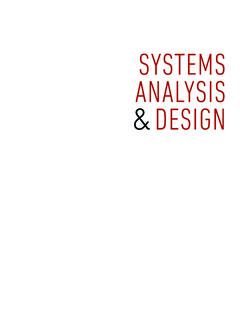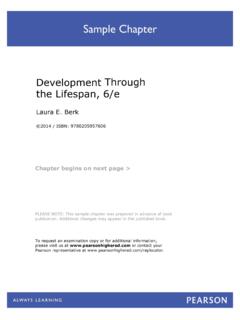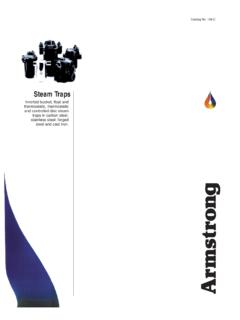Transcription of Chapter 14 Boilers - Pearson
1 Chapter 14. Boilers Objectives After completing this Chapter , you will be able to: Identify the components of Boilers and the purpose of Boilers in the process industries. (NAPTA Boilers 1, 3-5*) p. 292. Identify the common types of Boilers and their applications. (NAPTA. Boilers 2) p. 296. Explain the operating principles of Boilers . (NAPTA Boilers 6) p. 298. Identify potential problems associated with Boilers . (NAPTA. Boilers 11) p. 302. Describe safety and environmental hazards associated with Boilers . (NAPTA Boilers 7, 10) p.
2 303. Describe the process technician's role in safe boiler operation, maintenance, and operator qualification. (NAPTA Boilers 8, 9) p. 304. Identify typical procedures associated with Boilers . (NAPTA. Boilers 7) p. 304. * North American Process Technology Alliance (NAPTA) developed curriculum to ensure that Process Technology courses will produce knowledgeable graduates to become entry level employees in process technology. Objectives from that curriculum are named here in abbreviated form. For example, (NAPTA Boilers 2) means that this Chapter 's objective relates to objective 2 of the NAPTA curriculum about Boilers ).
3 Key Terms Air registers devices that control the flow of air to the burners to maintain the correct fuel-to-air ratio and to reduce smoke, soot, or NOx (nitrogen oxide) and CO. (carbon monoxide) formation, p. 297. Blowdown the process of taking water out of a boiler to reduce the concentration level of impurities. There are two types of blowdown, continuous and intermittent, p. 293. Burners devices that introduce, distribute, mix, and burn a fuel ( , natural gas, fuel oil, or coal) for heat, p. 297. 290. 290 29/06/2018 13:50.
4 Boilers 291. Coagulation a method for concentrating and removing suspended solids in boiler feedwater by adding chemicals to the water, which causes the impurities to cling together, p. 301. Condensate condensed steam , which often is recycled back to the boiler, p. 294. Damper a movable plate that regulates the flow of air or flue gases in Boilers , p. 297. Deaeration removal of air or other gases from boiler feedwater by increasing the temperature using steam and stripping out the gases, p. 301. Demineralization a process that uses ion exchange to remove mineral salts; also known as deionization.
5 The water produced is referred to as deionized water, p. 301. Desuperheated steam superheated steam from which some heat has been removed by the reintroduction of water. It is used in processes that cannot tolerate the higher steam temperatures, p. 300. Desuperheater a system that controls the temperature of steam leaving a boiler by using water injection through a control valve, p. 297. Downcomers tubes that transfer water from the steam drum to the mud drum, p. 297. Draft fan a fan used to control draft in a boiler, p. 297.
6 Economizer the section of a boiler used to preheat feedwater before it enters the main boiler system, p. 293. Filtration the process of removing particles from water or some other fluid by passing it through porous media, p. 301. Firebox the area of a boiler where the burners are located and where radiant heat transfer occurs, p. 296. Fire tube boiler a device that passes hot combustion gases through the tubes to heat water on the shell side, p. 298. Igniter a device (similar to a spark plug) that automatically ignites the flammable air and fuel mixture at the tip of the burner, p.
7 292. Impeller a fixed, vaned device that causes the air/fuel mixture to swirl above the burner; different from an impeller in a turbine or pump, p. 292. Knockout pots devices designed to remove liquids and condensate from the fuel gas before it is sent to the burners, p. 292. Mud drum the lower drum in a boiler; also called the water drum; serves as a settling point for solids in the boiler feedwater, p. 293. Pilot an initiating device used to ignite the burner fuel, p. 297. Premix burner a device that mixes fuel gas with air before either enters the burner tip, p.
8 297. Radiant tubes tubes containing boiler feedwater that are heated by radiant heat from the burners and boiled to form steam that is returned to the steam drum, p. 297. Raw gas burner a burner in which gas has not been premixed with air, p. 297. Refractory lining a bricklike form of insulation used to reflect heat back into the box and protect the structural steel in the boiler, p. 296. Reverse osmosis method for processing water by forcing it through a membrane through which salts and impurities cannot pass (purified bottled water is produced this way), p.
9 301. Riser tubes tubes that allow water or steam from the lower drum to move to the upper drum, p. 297. Saturated steam steam in equilibrium with water ( , steam that holds all of the moisture it can without condensation occurring), p. 300. Softening the treatment of water that removes dissolved mineral salts such as calcium and magnesium, known as hardness in boiler feedwater, p. 301. Spiders devices with a spiderlike shape that are used to inject fuel into a boiler, p. 292. Spuds devices used to inject fuel into a boiler, p.
10 292. 291 29/06/2018 13:50. 292 Chapter 14. Stack an opening at the top of the boiler that is used to remove flue gas, p. 297. steam drum the top drum of a boiler where all of the generated steam is collected before entering the distribution system, p. 293. steam trap a device used to remove condensate or liquid from steam systems, p. 294. Superheated steam steam that has been heated to a very high temperature so that a majority of the moisture content has been removed (also called dry steam ), p. 300. Superheater tubes located near the boiler outlet that increase (superheat) the temperature of the steam , p.











